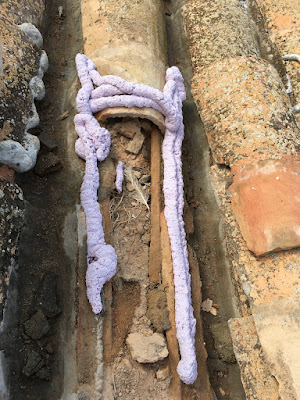In Tejado Engineer Jansen described work on the roof, in September 2022. It is now February 2023, and no, he has not finished yet.
The east part of the roof (pic below) has now been totally PUR-red and the ends are filled with lime mortar. What remains to be done to this roof half is put a bit of lime mortar on the cement arcs that were not replaced, for consistent color of the roof. Now there are dark patches where there is no new white blob of lime mortar.
yes, the walls are still having the barra Sahara mud rain stains
Last thing is: paint the sides, on the seams, with LANKO, a flexible cement originally intended for water basins.
Now for the west side
Same procedure. Test every cement arc at the end of the roof tiles if they are loose. If so: remove. See if there are remaining loose cement bits with a piece of iron wire bent into a small hook.
Then see if the tile itself is still firmly affixed. If not: remove, clean the sides with a copper brush. Clean the cement ridges where the tile was sitting, we want the tile to be exactly where it was, so no grit in between. Wet both tile and seat with a spray of water from the hose (spray gun), then apply PUR para Tejado to stick the tile in place.
yes, that is a bird's feather and remains of nesting material
fill the grooves where the tile was sitting with PUR
stick the tile back in place, a thin layer of PUR glues it to the roof
the end opening also is filled WITH PUR, it will still get a blob of lime mortar
When the PUR has hardened remove sPURious (ha ha ha) PUR with palet knife, put blob of lime mortar in the end openings. As the top rows here, bottom rows still have unremoved old cement:
For the west end all tiles have now been PUR-red.
Now the engineer is rather exhausted, his joints ache, his fingers are tired, and he's feeling old. These last pictures are January 29th 2023. Awaiting better weather and restored health.
Next step is remove spurious PUR, apply lime mortar blobs, and paint sides with LANKO.
Estimated two more months of work, as you can only do this a few hours per day max.
Results
There are great results too.
The roof no longer leaks, even though the roof tile sides still need treatment with LANKO.
Another great thing is that we no longer have grit in the house when it is windy. In the past we always had some grit along the central wall in the living room, and in the second bathroom. We even put up a row of IKEA cupboard to catch the grit in the living room. Not necessary any more. The canals under the roof tiles were all connected, and connected to the canal under the roof ridge. That is where the bat was, too. And because of missing cement arcs the canals were connected to the outside, too. So, wind blew the sand that is in those canals into the house. It was not that the gypsum layer was crumbling, that is fine.
It also explains why we always had wasps upstairs in the house in summer, despite all windows having mosquito screens. Where there were openings wasps got in, made little wasp nests under the roof tiles, and by mistake also came into the house.
Sorry, wasps, bats, birds.

























